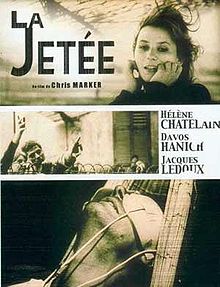 |
| Fig. 1 La Jetee Theatrical Poster |
Not really a film in the conventional sense of the word, this is the story of a survivor of a future war told using a montage of stock photos and special shot material. The story is narrated by the main character, starting with his visit to Paris' Orly Airport during which he witnesses a man being killed. "Shortly afterwards, Paris was blown up" he informs us blandly, as soaring choral music provides the soundtrack to a montage of images of bomb-damaged cities from WWII. In some ways, this is the most conventionally "filmic" scene of the movie - to any viewer aquainted with war films the combination of classical music and scenes of destruction will be familiar.
The survivors of the war are forced to live underground as a result of radiation, and the victors use their captives (including the protagonist) as guinea pigs in unspecified experiments that are described as leading to death or madness. One day, the protagonist is chosen for experimentation, and taken to meet the scientist in charge. While the other victors wear strange and sinister glasses (probably to dehumanise them and enhance the audience's perception of them as "bad guys"), the scientist is revealed to be a perfectly ordinary-looking man, who explains that he is working to try and save humanity.
 |
| Fig. 2 La Jetee [Film Still] |
The rest of the story involves his repeated visits to the past, during which he starts a relationship with a woman he remembered seeing at Orly Airport, before he successfully contacts the future and delivers his message.
When watching the film, it is interesting to note the way that the prewar period is photographed in a relatively well lit way, while the postwar scenes have a high contrast (accentuated by the black and white film) with stark shadows and harsh lighting. Meanwhile, the scenes where the protagonist makes contact with the future are the most abstract, with strange abstract patterns resembling cloud-chamber tracks overlaid upon black clad figures standing against a black background.
 |
| Fig, 3 Future Humans [Film Still] |
List of Illustrations
Figure 1. Argos Films (Org) (1962) "La Jetee" Theatrical Poster [Digital Image] At: http://www.kurzweilai.net/images/220px-La_Jetee_Poster.jpg (Accessed on 08/02/2011)
Figure 2. Argos Films (Org) (1962) La Jetee [Film Still] At: http://mimg.ugo.com/201003/40327/la-jette.jpg (Accessed on 08/02/2011)
Figure 3. Argos Films (Org) (1962) La Jetee [Film Still] At: http://www.ballardian.com/images/chris_marker_la_jetee.jpg (Accessed on 09/02/2011)
Bibliography
Crowther, Bosley (1967) Movie Review - Castles for Two (1917) - Screen: Short-Film Show: New Cinema Brings Back Some Favourites of Cinema 16 for Lincoln Center Series In: The New York Times [Online] At: http://movies.nytimes.com/movie/review?res=9D04EFDD113CE53BBC4E52DFB766838C679EDE&partner=Rotten%20Tomatoes (Accessed on 09/02/2011)
Film4 Staff La Jetee (1962) In: Film4.com [Online] At: http://www.film4.com/reviews/1962/la-jet-amp-233-e (Accessed on 09/02/2011)
TimeOut Staff (1962) La Jetee Review In: TimeOut London [Online] At: http://www.timeout.com/film/reviews/77181/la_jetee.html (Accessed on 09/02/2011)

No comments:
Post a Comment